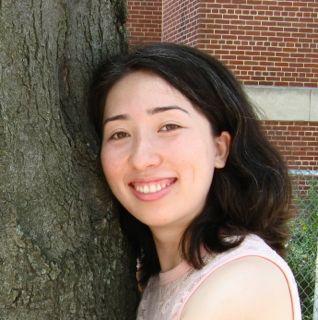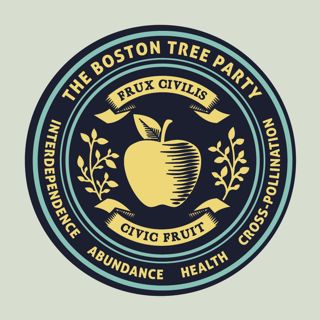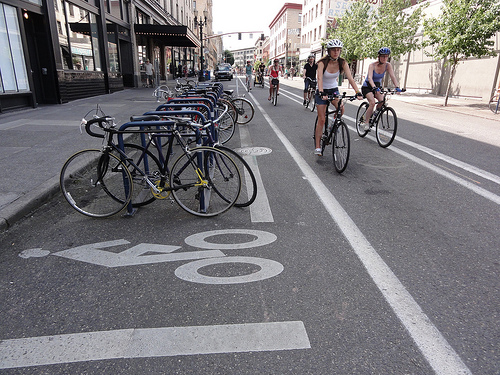 Lisa Gross.Lisa Gross is an artist and urban food activist who heads up a budding coalition called the Boston Tree Party. The group organizes the planting of pairs of heirloom apple trees around the city of Boston in the hopes of ultimately forming a patchwork of free fruit and community engagement.
Lisa Gross.Lisa Gross is an artist and urban food activist who heads up a budding coalition called the Boston Tree Party. The group organizes the planting of pairs of heirloom apple trees around the city of Boston in the hopes of ultimately forming a patchwork of free fruit and community engagement.
Inspired by what she calls the City of Apples, Gross has worked with delegations of tree stewards all around the city to transform Boston’s public spaces, as well as the social and environmental health of its residents. An artist with an MFA from the School of the Museum of Fine Arts and Tufts, Gross runs an umbrella nonprofit called Hybrid Vigor Projects. She’s also the founder and head of Boston’s Urban Homesteaders’ League.
The Boston Tree Party launched April 10, 2011, with the planting of its first pair of apple trees. Gross spoke to us recently amidst her work to begin ramping up for the next planting season.
Q. What does the Boston Tree Party do?
A. Our motto is civic fruit, and we call for the planting of fruit trees in civic space. So we really see these trees — which are planted by communities on land that they are somehow connected to or control — as a focal point for community engagement.
The thing is, we’re not trying to get permission to just plant trees anywhere. We’re starting with communities who want to plan and care for these trees. We want to know who is going to take care of them, and how it’s going to be structured. We built a framework and work with [community] delegations to give them a planting kit and help them learn how to care for the trees.
The trees are only a year old, so they don’t have fruit yet. Once they start producing, we will be organizing workshops and events on how to use the apples, because there are so many fun, exciting things that you can do with them!
Q. What’s special about planting a fruit tree, versus, say, a vegetable patch?
A. These trees are also tools of environmental restoration. In our tree planting kits, we had soil amendments which were specific to fruit trees. We had compost, mycorrhizal root dip — which extends the trees’ ability to absorb nutrients by about tenfold — and wood chip mulch, which mimics the forest floor and helps to develop mycorrhizal fungi. So planting these trees — and in this way — also helps the health of the soil. The root systems also absorb rainwater runoff, and they’ll contribute to the tree canopy of the city and help to improve air quality.
Plus, you can plant fruit trees in areas where you couldn’t grow other kinds of vegetables — areas with medium levels of lead because the lead goes to the bark and leaves and not the fruit. And [trees] can help to remediate the soil that way too.
Q. What prompted you to reference the Boston Tea Party?
A. You know, living in Boston you’re always surrounded by colonial history and colonial kitsch, and when I started to research the history of Boston, I discovered that the first apple orchard planted in the United States was actually planted on Beacon Hill by the European settler William Blackstone. Beacon Hill is this icon of Boston history and power, so just to think of that as an apple orchard was really beautiful. Also, the oldest named variety of apples to grow in the United States is the Roxbury Russet, which was developed in Boston in the 1630s. So you have this idea of Boston as the City of Apples.
I started going to farmers markets around Boston; I collected about 50 different varieties of apples and I did a tasting with a friend. It was just this whole world opening through this fruit that we so often take for granted. And then I discovered that there is this really interesting biology and ecology to apple trees in that they need to be planted in pairs to cross-pollinate. And I just thought that was such a beautiful image and metaphor.
The Boston Tea Party has become so widely relevant with the rise of the contemporary Tea Party and I was fascinated to learn that, in a way, [that event] was a performance. The dumping of the tea had a financial impact, but … it was also a dramatic, symbolic performance. So the Boston Tree Party is a kind of reference to both a celebratory party and the performance of it all.
Q. Did you have to educate the public and say, hey these trees are yours, it’s okay to eat the fruit?
A. As part of developing the project I met with everyone I could from a [now defunct] organization called Earth Works, which had spent about 10 to 15 years planting trees in public spaces. One of the things they said was this: people didn’t know they could pick the fruit, especially people from low-income backgrounds who felt more worried about trespassing. And, more generally, they wondered: Is it poisonous?
And so one of the more important things has been the creation of tree plaques, which we’re actually going to be distributing this winter, that include the variety of the apple, and say “Boston Tree Party 2011” and “Free Apples.” I think having these markers will help to activate those trees.
 The official seal of the Boston Tree Party.Q. Did you find people pushing back, saying things like: fruit trees are just way too messy?
The official seal of the Boston Tree Party.Q. Did you find people pushing back, saying things like: fruit trees are just way too messy?
A. [Chuckles] When you talk about fruit trees in the city, the first thing people say, is “I don’t want fruit dropping on my car!” That’s why I think it’s very important from the beginning to have a care structure. If you have a whole church, business, or school caring for two apple trees, you can collect what drops, and prune the trees. We’re also not saying, “Hey, elementary school, plant 40 fruit tress.” We’re saying, “Plant two and see how things go.”
Q. Why do you think you’re so inspired by growing food?
A. I grew up in a Maryland suburb of Washington, D.C., and my Korean grandmother lived with us my whole life. Even when we lived in apartment buildings she grew Korean vegetables. And I think that really fascinated me as a kid — that wherever we were she was always growing some sort of food because it was so much a part of her culture.
When I was a kid, I kind of took it for granted — seeing her save seeds every year and carefully tend her squash and peppers — but I think that experience really stayed with me and informed my work and interests.
Q. Can you explain how your ideas of cross-pollination fit into the Boston Tree Party?
A. Being multiracial I’ve always been navigating cultural divides. So I think in some ways the idea of cross-pollination or the idea of interdependence and coming together across differences as a way to create better fruit is something that comes out of my personal experience.
Q. I have to ask, what’s your favorite fruit?
A. Apples. I grew up on the East Coast, where it’s a yearly tradition to go pick apples in the fall. It always represented this sense of abundance. The Golden Russet is my favorite right now.
Q. Do you have advice for people who might want to star
t something similar in their city?
A. I think a project like this is all about relationships. I had a zillion meetings with a zillion people from all different organizations and that’s what really got the projects going. And so everyone I talked to put me in touch with someone else. [The Boston Tree Party] is really built on that kind of legwork.
Q. Do you have plans to expand the project?
A. We have a few things in the works. We’re partnering with the MIT Center for Civic Media and a Hacks/Hackers to create an online interactive map and smart phone app with all the civic fruit in the Boston area. It will be a directory to this massive decentralized urban orchard we’re creating.



